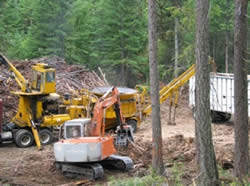
National Fire Plan Success Story
Biomass Utilization
Fire and Fuels
Colville National Forest, Washington
National Fire Plan - Fuels Reduction
2008

Woody biomass utlization chipping operation.
In fall of 2008, the Three Rivers Ranger District of the Colville National Forest (NF) had a contractor, Vaagen’s Brothers, grind 28 landing piles for biomass utilization as part of the Bangs Stewardship Contract. This Healthy Forest Initiative Project, the 2005 Bangs Wildland Urban Interface (WUI) Project, aimed at reducing the risk of wildland fire to adjacent private lands and provided for improved safety to firefighters undertaking any future fire suppression. The 28 piles were on landings that had ample room for the grinding equipment and haul trucks to operate safely, and were adjacent to good roads. The power generating station that processed the material, operated by Avista Corporation, was located a convenient 12 miles from the project site. This was the Colville NF’s first experience with including biomass utilization in a stewardship contract.
For this particular project the sub-contractor, Bigfoot Trucking, used a tub grinder (cylinder-shape mechanism, made of steel and approximately 12 feet in diameter) and pulled on a tractor trailer with a conveyor belt and grapple (mechanized claw) attachments. The grapple ‘grabbed’ material out of the piles and placed it into the tub grinder, which in turn ground it into chips. The conveyor belt moved the chips to a separate tractor-trailer chip van that transported the material to the power generating station. They had to short haul some piles with a dump truck from locations not suitable for larger equipment.
The 1,581 tons hauled to Avista’s Kettle Falls Generating Station was some of the woody residue from timber harvest on 522 acres. This averaged out to 3.0 tons per acre of residue for biomass. While the initial estimates show the cost of paying the contractor for the grinding operation was greater than that of burning the piles in place, other non-economic benefits must be considered. Smoke emissions released while being processed at the Avista Plant were less than burning the piles in place, and the material generated energy for local communities. Ron Gray, representative from the Kettle Falls Generating Station, estimated the Bangs WUI Project produced 1,128 megawatts, enough energy to meet the needs of about 100 homes for one year.
The Three Rivers Ranger District is continuing to analyze the cost-benefit of biomass utilization. Based on this experience, it appears to be a prudent way to dispose of landing piles.
For more information contact Shane Robson, Colville National Forest, Fuels Assistant Fire Management Officer, (509) 738-7730, email: srobson@fs.fed.us